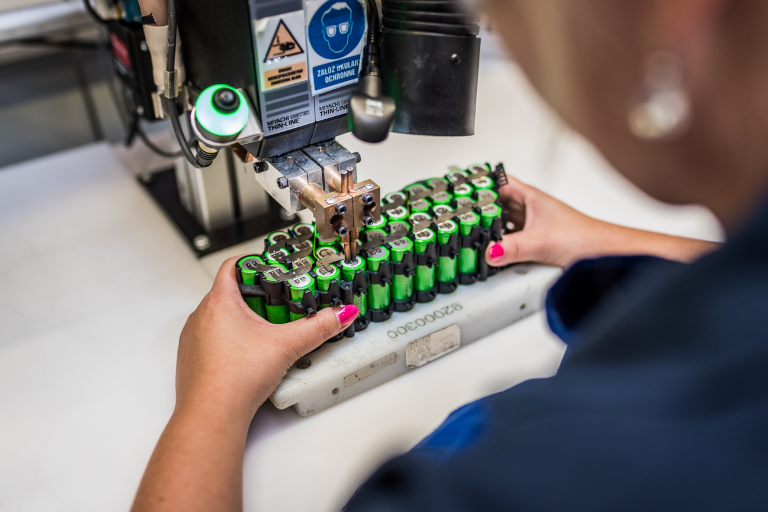What is a lithium-ion battery? It’s the most popular and powerful type of rechargeable battery available in today’s markets. Read more!
Table of Contents:
The Takeaways:
- High Energy Density: Lithium-ion batteries store more energy in a compact size, resulting in longer device runtime.
- Long Cycle Life: They can be charged and discharged many times without significant capacity loss.
- Low Self-Discharge Rate: They retain their charge for extended periods when not in use.
- Lightweight Design: Their compact and lightweight nature makes them ideal for portable devices.
- Safety Considerations: Proper handling, storage, and disposal are essential to ensure safety and environmental responsibility.
What is a lithium-Ion battery made of?
As the name suggests, lithium-ion batteries contain one or more lithium-ion cells. These are the fundamental building blocks of any lithium ion battery system. These cells themselves contain two electrodes – an anode and a cathode – placed inside to send and receive electrical current, which ultimately is sent to the device powered by the battery system.
The electrodes themselves are typically designed using graphite and a metal oxide applied on cooper or aluminum foil. In between both electrodes is a separator used to prevent battery shorting. An electrolyte gel surrounds the middle to aid in conducting the ions. This basic structure illustrates the core materials used in lithium ion batteries, which are constantly evolving to improve efficiency, energy density, and safety.
This setup reflects the core of lithium ion technology – efficient ion flow between electrodes, which makes such batteries lightweight, rechargeable, and high-density.
Of course, modern batteries have evolved substantially from their original designs. Most, if not all, now include thermal management systems and other safety features. The complexity of the chemistry taking place inside the battery has also drastically increased. Today’s lithium-ion battery technology incorporates nanotechnology, solid-state electrolytes, and advanced electrode materials for superior performance.
Lithium-Ion batteries – Possible applications
Now that we know what a lithium-ion battery is made of, the next logical question to ponder concerns its practical applications. So, what is a lithium battery used for, and where does lithium ion technology really shine? Their range of applications extends far beyond just smartphones and laptops. Take a look at the list below for a fuller breakdown.
E-Bikes & E-Mobility
Lithium-ion batteries found a seemingly perfect home in many transport-related applications, like electric bikes and vehicles. Thanks to them vehicles are silent and do not produce exhaust gases.
The prevailing challenge in such applications concerns battery capacity. Some remain apprehensive about electric vehicles, citing frequent charging stops as the major block preventing the technology from being more widely adopted. Still, over time, both the charging infrastructure and innovation in battery chemistry will lead to longer driving ranges and faster charging times.
Lithium ion battery packs are now engineered with higher energy densities and advanced cooling systems to meet the demands of modern e-mobility.
Power Tools
In the world of power tools, lithium-ion batteries brought about significant change by offering wireless operation without the heft of cadmium or nickel-based batteries. Overall, Li-ion solutions provide greater efficiency and reliability. Their longer battery lifecycles also translate into savings and a positive environmental impact. This is a direct result of the versatility of lithium ion technology in both consumer and industrial-grade devices.
Energy Storage
Our energy output capabilities have been continually increasing with the advent of renewable sources. As manufacturing costs steadily drop, making the technology more accessible and popular, the greatest challenge we face concerns our capacity to stockpile these reserves when they’re not needed, and release them into electrical grids during peak usage hours.
Lithium-ion batteries contribute heavily to the energy storage landscape as a cost-effective and scalable method to control supply and demand. As lithium-ion battery systems become more efficient, they are playing a key role in stabilizing renewable energy infrastructure. And, with ongoing research, energy density and battery chemistry will continue to improve, offering greater integration of renewable energy, and an increased reliability of electrical supply grids.
Health Care
Steady improvements in the health care sector allow lithium-ion batteries to shine. Medicine is the perfect example of just how far we can take technology to make our lives better, safer, and healthier.
So, what are lithium-ion batteries used for in this context? They are the go-to solution for powering many portable medical devices, including cardiac defibrillators, drug pumps, medical carts, and glucose monitors.
Because of their lightweight and rechargeable nature, lithium ion batteries are ideal for life-saving equipment where consistency and safety are critical.
The takeaway
Now you know what lithium batteries are, what they’re made of, and what they’re most commonly used for. As continued advancements in the fidelity of lithium-ion technology are made to cater to our ever-increasing demand for stable energy storage, excitement is certainly on the horizon.
Whether you’re looking at energy storage, transportation, or healthcare, the lithium ion battery remains the cornerstone of modern portable power.
You may also read: What Is a Battery Management System?
What is a lithium-ion battery?
How does a lithium-ion battery work?
What are the main components of a lithium-ion battery?
About the Author
EMBS
Leading manufacturer of advanced battery systems with a market presence of over 25 years. We specialise in rechargeable lithium-ion batteries, producing a wide range of systems with varying power and capacity.
